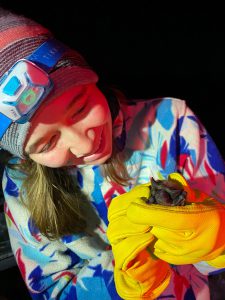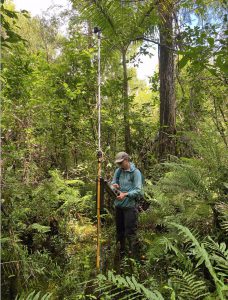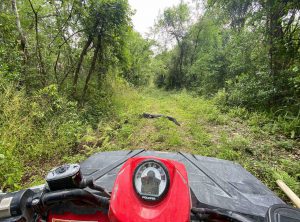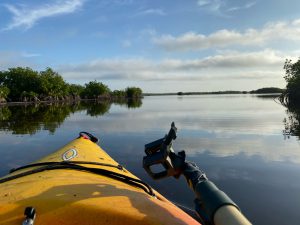By Katrina Rossos

Laura Nicholson, a master’s student in the Department of Wildlife Ecology and Conservation at University of Florida, has spent the past eight months at Picayune Strand State Forest in Collier County, Florida. She is comparing bat activity across different landscapes within the forest and against its neighboring preserved land. Nicholson hopes to also learn about the habitat preferences of varying bat species, particularly the endangered Florida bonneted bat, of which little is known.
Advised by Drs. Holly Ober and Liz Braun de Torrez, her ecological interests lie in understanding wildlife population responses to human influences. By studying habitat use preferences of threatened species, Nicholson said she hopes to help save vulnerable populations.
Originally from White Bear Lake, Minnesota, Nicholson’s love for nature and wildlife was awakened at a young age. “I specifically drew a lot of inspiration from my mother, who has been a passionate conservationist and self-avowed tree hugger her entire life. She strongly encouraged my siblings and me to appreciate the outdoors and all creatures living in it,” said Nicholson.

Research and Field Work
This project has two field seasons, and Nicholson will return to South Florida to begin collecting data again in January 2021. Data collection spanning such a long time period enables Nicholson to measure any disparities between the wet and dry seasons. The research will provide a fuller picture as to how a large-scale, ongoing hydrologic restoration project in the Picayune Strand State Forest is affecting the Florida bonneted bat and other resident bat species. The added knowledge of learning habitat preferences of Florida bonneted bats will help better manage their survival.
The hydrologic restoration project includes the removal of hundreds of miles of roads and four canals and that were constructed in the 1960s when builders attempted to create the largest sub-division in the world. However, despite attempting to drain the area, the land turned out to be too wet during the rainy season for building. Restoring the land to how it was historically should reestablish old water flow patterns and habitat characteristics over time.
Currently, the park has three different gradients of restoration: unrestored, partially restored, and fully restored. Therefore, the park provides an ideal environment for monitoring bat activity among varying habitats.

Day-to-Day in the Field
On a typical day, Nicholson would travel to one of the five field sites where she would either deploy, move, or remove between three to six field acoustic detectors; a total of 97 acoustic detectors were dispersed throughout the state forest. Since the detectors were remote and far part, a lot of Nicholson’s time was spent traveling to the detectors, either by car, ATV, kayak, or hiking on foot. Once at the field sites, she would program the acoustic detectors, set up game cameras or hydrostations, and collect data on the type and density of vegetation to compare plant diversity and forest structure among the habitats. Then, Nicholson downloaded and processed all the data and prepare for the next day, she explained.

Thinking Outside of the Kayak
One of the more memorable moments working in the field this year came when Nicholson effectively donned snowshoes to cross a muddy bay.
“We were trying to access a site that we usually kayak to, but as it was the height of the dry season, our beautiful mangrove bay had turned into a flat pan of brownie batter,” Nicholson described. “After a few initial attempts to walk in, leaving me at one point almost thigh-deep in mud grasping for escape, we realized we needed to find an alternative option.”
One of Nicholson’s advisors jokingly offered a pair of snowshoes to trudge across the bay, and, anxious for a solution, she tried them on and they worked.
“We honestly couldn’t believe it, but with some practice, we found that if we just kept walking and didn’t pause at any one point for more than a few seconds, we could make our way over the muddy pass to our site,” she said. “It definitely made me appreciate the amount of creativity and unique problem-solving that can go into field research.”

Looking to the Fall
This fall, Nicholson is looking for undergraduate volunteers to help process and identify collected insect samples. Since bats eat insects, they are a key link between hydrology and bats, according to Nicholson. Seeing how communities of insects differ as the degree of restoration within the state park changes, will indicate a clearer connection as to how restoration amounts affect bat activity. Nicholson suspects that insect abundance is higher in areas with more water flow.
“No experience needed, but obviously any interest or experience in entomology is great! We are looking for volunteers who are excited about research, patient, determined, and flexible.”
Anyone who is interested or has questions, please send an email to lnicholson@ufl.edu.
 1
1
